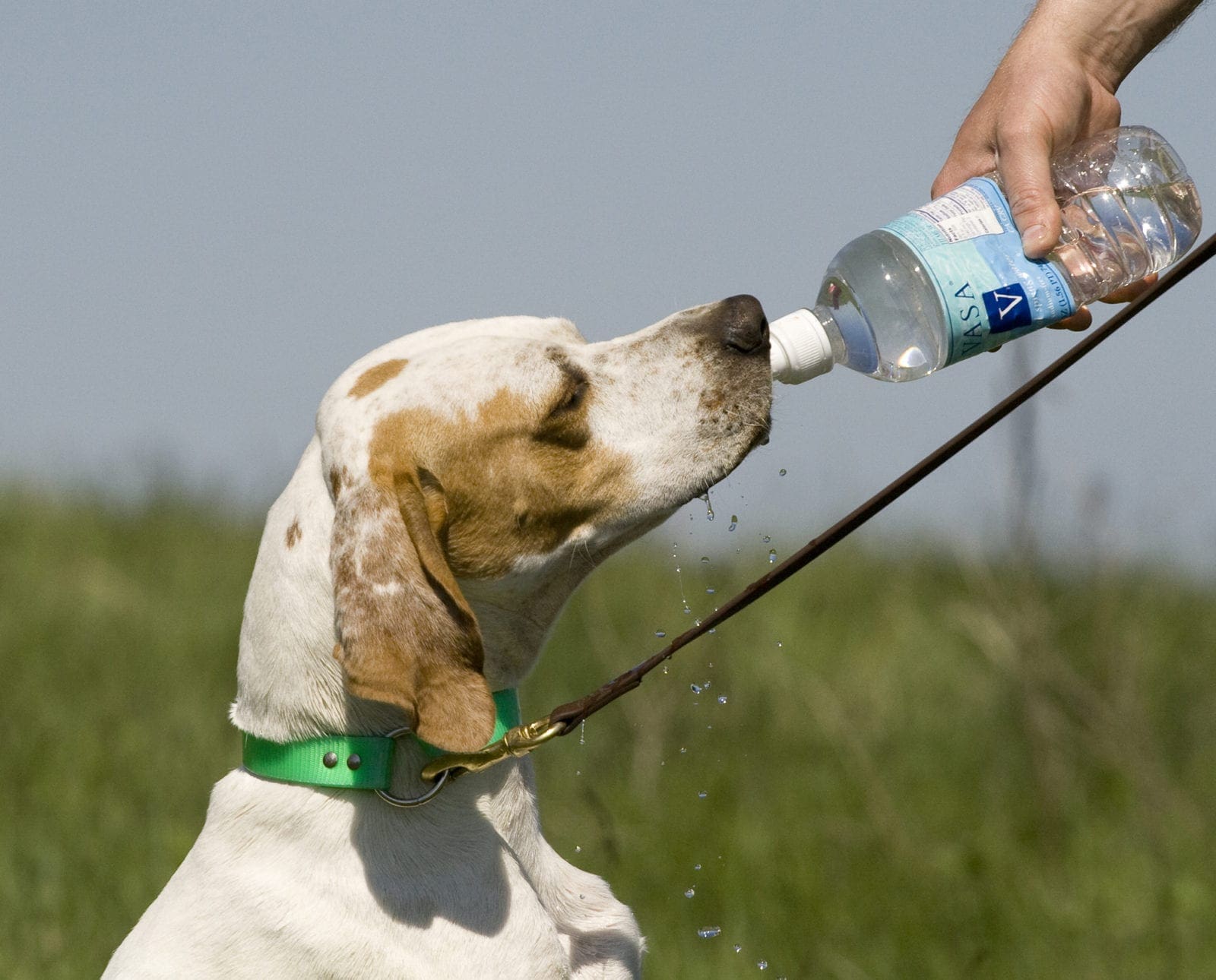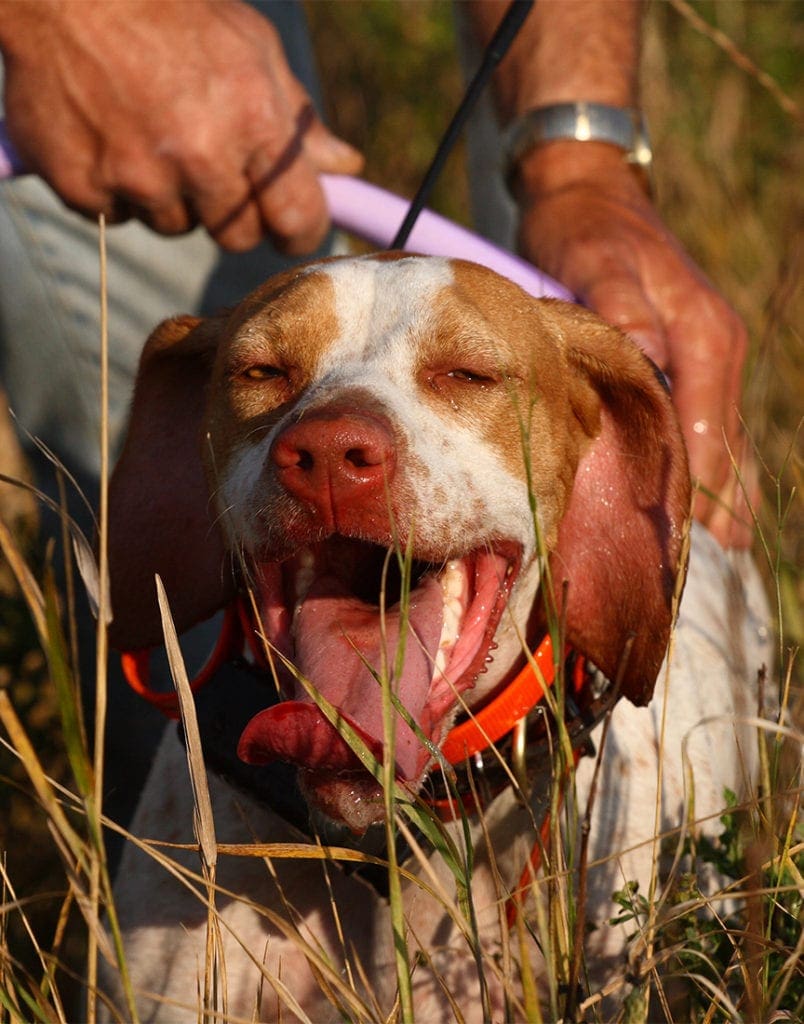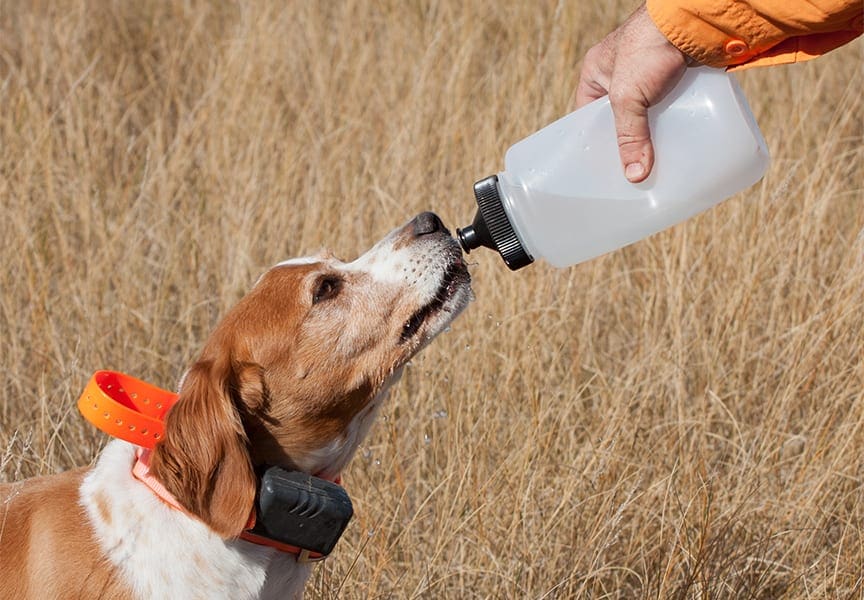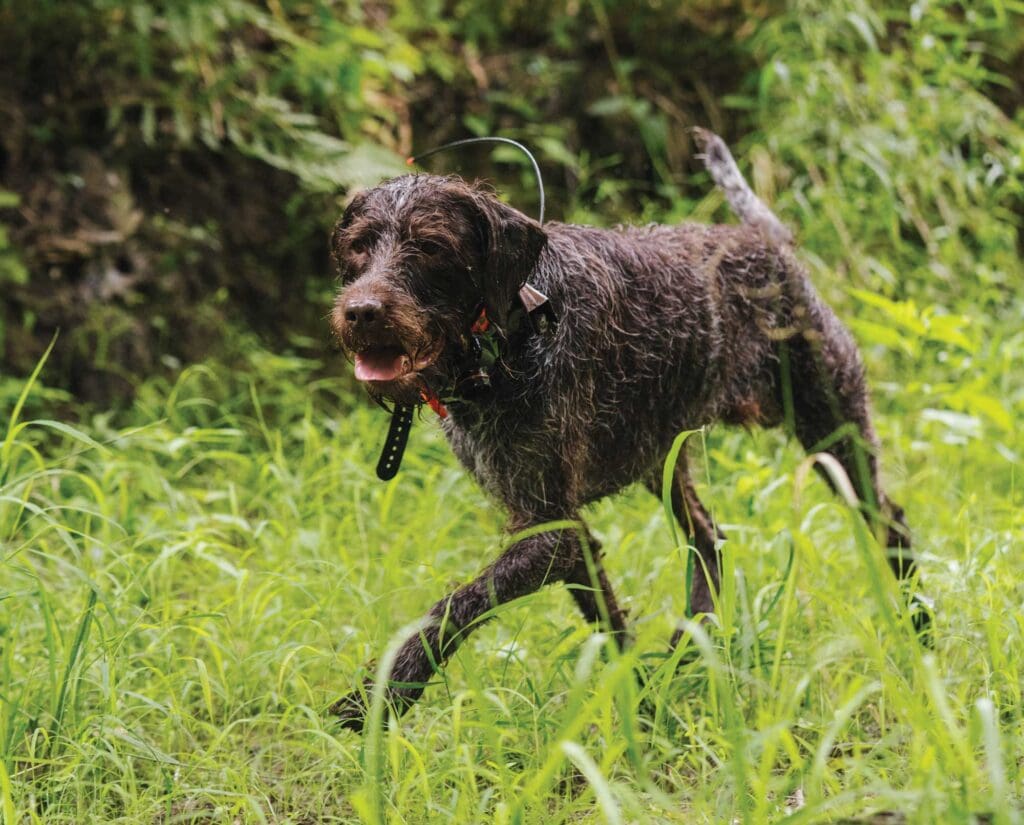Home » Hunting Dogs » Protect Your Dog from Overheating and Heat-Related Illness
Protect Your Dog from Overheating and Heat-Related Illness
- This story originally published in the Fall 2020 Hunting Dog Confidential Issue 1.1.

"Dr. Joe Spoo is a graduate of the Iowa State…
Joe Spoo DVM, DACVSMR explains the signs of heatstroke in hunting dogs and how to prevent it while in the field
It wasn’t quite noon on the prairie and the light northwest breeze made the early season hunt seem almost cool. Usually on these early September prairie grouse hunts I would call it quits by noon, but after a rough summer at work and this being my first outing of the season, I decided Emma and I could make one more loop.
Listen to more articles on Apple | Google | Spotify | Audible
We started into the cool breeze with the sun at our backs and life was good. For a Chesapeake, Emma was quite athletic in the uplands and covered ground gracefully. I was lulled into the enjoyment of the moment and continued across the prairie. As we looped around to head back to the truck, my heart sank; the now-midday sun was blazingly hot as we marched toward it and the light wind that was now at our back offered no relief. While Emma was graceful in the uplands, one thing she definitely wasn’t was heat tolerant. I knew we could be in trouble by the time we got back to the truck.
I soaked her with my one remaining water bottle and hoped for the best. By the time we made the truck even I was miserable and Emma’s harsh panting, wide tongue, and vacant look in her eyes told me I came very close to pushing my best friend too far. I quickly fired up the truck’s air conditioning, soaked her again, and put her in front of the vents. Her breathing came under control and my dog was back; I knew I had dodged a bullet. Nearly 20 years later, there hasn’t been a time that I turn a dog loose I don’t think about the conditions we are starting under and how those might change while the dog is working.

What to know about working dogs in extreme temperatures
A vast majority of hunting dogs in North America start their seasons with temperatures that can reach the 90s in the early season. Those same dogs may end their seasons by hunting in wind chills 10-20 degrees below zero. That is more than a 100-degree swing over the course of a working season. Emma was certainly one of those dogs who would start with early-season dove and grouse hunting and end the year on late-season ducks and pheasants. When asking a dog to work in such extremes, it is vital to understand your dog, the weather, and what to do should they experience the extremes of hyperthermia or hypothermia.
While it’s important to understand the signs and treatment for both extremes, I will say that heat stroke, or hyperthermia, is much more common than hypothermia. It’s also a condition that we tend to cause as handlers. As a veterinarian who specializes in hunting dogs, I get to interact with a lot of gun dog owners from all over the country. I am commonly asked about hypothermia and almost never asked about hyperthermia. In contrast, the reality is that we unfortunately lose dogs to heat every single year and yet in 20 years of practice I’ve not lost one patient to hypothermia.

What causes hyperthermia?
Overheating is a condition that develops from the body’s inability to regulate its own temperature. Basically, the heat being produced by the body is greater than the heat being dissipated.
The causes of heat stroke in hunting dogs are numerous, but at the top of the list is a lack of conditioning. Too many hunters take their dogs from the couch or the kennel straight into the field without any thought about the dog’s level of conditioning. This would be akin to taking most of us on a given day and demanding that we run a marathon…at the drop of the hat. The difference is that we’re able to say no and are in tune with our bodies enough to know when to stop. Our dogs, on the other hand, love to hunt and love to perform; by the time they are showing signs of a problem, it is often too late.
Other causes of overheating include lack of acclimatization, high humidity, and high temperatures. A rule of thumb used by many dog trainers down south is that if the sum of the ambient temperature added to the relative humidity is greater than 150, you probably shouldn’t be running your dogs. Heat stroke can still develop at lower temperatures, but this is when it becomes particularly dangerous. You’ll also see heat problems with too much exercise done too soon without a warmup. Also, an obese animal is going to be much more prone to overheating than one running at a lean body weight. Previous episodes of overheating will predispose a dog to overheating again, because overheating can cause the body’s internal thermometer to become dysregulated and make the dog more susceptible to future episodes.
It is also important to know that a dog in water can still experience heat stroke. This is particularly true in the summer and early fall when many of the shallow bodies of water have had time to heat up. At these times it can be like swimming the dog in a hot tub. Just because they are wet does not mean they are cool. The bottom line is that you should always try to be smart when working your dog in any type of heat.

Signs of hyperthermia
Signs that your dog may be getting close to overheating include heavy panting and/or extreme hyperventilation. These dogs are not just hot; they are trying to move as much air as possible in an often-futile attempt at dissipating body heat. Many of these dogs will also be hypersalivating. They will come back with long ropes of drool coming out of their mouths or puddles of saliva around them. They will also have an altered mental state and appear glassy-eyed. Often when you look at these dogs they will look like they are in trouble, almost as though no one is home when you look them in the eyes. Many will become ataxic (stumbling and incoordination) and show muscle weakness. Often, but not always, there may be vomiting or diarrhea. From here it may progress to total collapse.
At this point you are probably wondering what temperature the body has to reach to fall into the category of heat stroke, but unfortunately there isn’t one particular number. The normal body temperature of dogs is 100-102.5 F, but in normal working dogs without heat stroke, we can have temperatures during and immediately following exercise that get up around 106-107 F without causing a problem. But these are the same temperatures at which we start worrying about heat damage starting to occur with heat stroke.
This is where having a thermometer in your emergency kit becomes important. If your dog’s temperature does not begin to fall immediately, or worse it continues to climb, after the exercise is stopped, then your dog is in trouble. To better understand your four-legged hunting partner, I recommend taking your dog’s temperature after a day of hunting or while out training when you are not even close to crossing the overheating line. This will give you an idea at what temperature your pup typically runs while at work and will allow some sort of baseline if you ever get into trouble out in the field.
During heat stroke, all the body systems are affected. The tissues of the body are essentially cooking themselves as proteins denature. When we get these dogs into the clinic they have severe blood chemistry abnormalities, including acute liver disease and kidney failure. They can develop a coagulopathy and bleed internally or develop a respiratory distress syndrome. All of these conditions can quickly lead to death if not treated immediately and aggressively.
How to treat overheating dogs and when to seek veterinary care
As far as starting treatment in the field, the most important thing is to get them cooled down. If there is water around, get them a cool water bath or spray them down. If you are going to cool them in standing water, be sure to wade in and hold on to them, as they could collapse and drown or get out too deep and not be able to make it back. Apply ice to the hairless portion of the belly and especially deep in the armpits and groin, as there are some very large blood vessels in these areas that help cool them down quickly. You may also get them in the vehicle with the air conditioning on high and the fans blowing directly on the dog.
During the entire cooling process, monitor the dog’s temperature and stop cooling them when the temperature reaches 103 F. This will make sure you are not cooling them too fast. It is very easy to over-cool these dogs and drop them down too low and end up causing hypothermia. Remember—the internal thermostat is no longer working correctly.
If it appears that your dog has experienced heat stroke and is showing symptoms, seek veterinary attention. It is important to continue attempting to cool your dog down while transporting them to a vet. Hospitalization, monitoring, and supportive care are very important and in many cases are a necessity in order to save these dogs. Many dogs that survive may have long-lasting problems; the sooner they receive veterinary care, the better their chances.
"Dr. Joe Spoo is a graduate of the Iowa State University College of Veterinary Medicine. After graduation he practiced in the grouse woods of northern Minnesota before relocating to the prairies of South Dakota where he has spent the last 16 years chasing birds with dogs. Spoo’s passion is the canine athlete and he believes in a cradle-to-grave approach to managing the canine athlete.Dr. Spoo is a Diplomate of the American College of Sports Medicine and Rehabilitation and the only such specialist who has committed his career to hunting dog health and expanding our field of knowledge of these amazing athletes. In addition to his practice responsibilities, he has an active consulting business serving sporting dog owners and the sporting dog industry. He also manages a website (www.gundogdoc.com), a comprehensive resource for all things gundog related."




What are your thoughts on the cooling vests on the market? Not in a hunting situation; due to snagging, but during regular exercise or for rest breaks? I’ve understood the cooling of the underside of the dog (or paws) and read that water on their back does not assist in cooling them, so how do these products benefit them?
Opening grouse yesterday with my not quite one year old Griff. Started at 6:30 am quit by 9 am same today. Made sure she had plenty of water and we went slow. Yesterday hit 90 and same today so no reason to keep them out in that heat. And we shot a limit of sharptails. I was told pouring rubbing alcohol on their backs can cool them down?